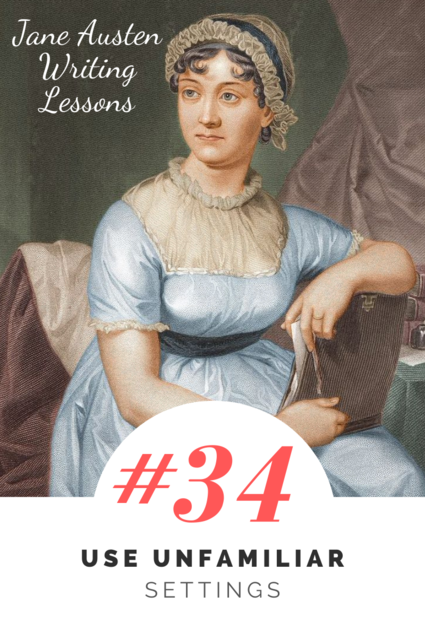While Jane Austen often paints familiar and sometimes even invisible settings for her scenes, at other times she relies on unfamiliar settings for her characters. The majority of the novel Northanger Abbey takes place in settings that are initially unfamiliar to the main character, Catherine: the town of Bath, and Northanger Abbey.
Much of what we have previously discussed about settings applies when unfamiliar settings are used:
- The description of the setting reveals the characters emotions and states of mind.
- A distinctive setting (which may be an unfamiliar one) can be a powerful location for a key plot turn.
- Like with familiar settings, a small amount of description can establish an unfamiliar setting, while at other times a large amount of description may be necessary. (In my own Jane Austen-inspired novel, The Secret Life of Miss Mary Bennet, when Mary first encounters Castle Durrington I provide a rather detailed description of the castle, because an understanding of the castle’s layout is essential for later elements of the mystery. Yet many of the other unfamiliar settings receive only brief descriptions.)
In addition to the above principles, there are two additional considerations that must be made when writing an unfamiliar setting:
- How do the character’s expectations of the setting compare with the reality of the setting?
- How does being in an unfamiliar setting impact the character’s behavior?
Expectations vs. Reality
Catherine Morland’s trip to Bath with the Allens is her first adventure away from home. We read:
They arrived at Bath. Catherine was all eager delight;–her eyes were here, there, everywhere, as they approached its fine and striking environs, and afterwards drove through those streets which conducted them to the hotel. She was come to be happy, and she felt happy already.
Her arrival reflects her emotional excitement, and at the moment, Bath matches or exceeds her every expectation. Yet as her stay in Bath continues, her understanding of the city becomes more complex and nuanced: a crowded ball where they do not know a single soul; another ball where they meet the charming Mr. Tilney; a chance meeting of an old friend of Mrs. Allen, which leads to an instant friendship for Catherine with Miss Thorpe; and dangerously-fast carriages rushing down the roads and making it impossible for individuals to cross.
Time and time again Catherine’s expectations meet the reality of Bath. Sometimes Bath exceeds expectations, sometimes it meets expectations, and sometimes it disappoints.
A photo from my trip to Bath in 2019. My only regret is that we didn’t spend longer there.
Even if expectations are not fully formed, characters always have some sort of expectations about new, unfamiliar places, and comparing or contrasting those expectations with reality is a useful tool.
Expectations once again face reality when Catherine visits Northanger Abbey:
As they drew near the end of their journey, her impatience for a sight of the abbey…returned in full force, and every bend in the road was expected with solemn awe to afford a glimpse of its massy walls of grey stone, rising amidst a grove of ancient oaks, with the last beams of the sun playing in beautiful splendour on its high Gothic window. But so low did the building stand, that she found herself passing through the great gates of the lodge into the very grounds of Northanger, without having discerned even an antique chimney.
She knew not that she had any right to be surprised, but there was a something in this mode of approach which she certainly had not expected….
This time, Catherine is not only much more aware of the different between her expectations and reality, but she behaves differently now that she is in a new, unfamiliar setting.
How characters behave in an unfamiliar setting
Different people behave differently in new settings: with boldness or timidity, with wonder or disdain, with brashness or with care. For some characters, a new unfamiliar setting is removing them from their comfort zones, while for others, it is a chance to leave behind previous constraints.
How a person behaves when in an unfamiliar setting reveals much about their character.
When Catherine attends her first ball in Bath with Mrs. Allen:
Catherine…kept close at her side, and linked her arm too firmly within her friend’s to be torn asunder by any common effort of a struggling assembly.
Catherine fears being swept aside, lost, or “torn asunder.” She stays close to the side of her friend, and rather than being active, she passively is impacted by the choices of others.
Contrast this with her behavior when she arrives at Northanger Abbey:
Catherine’s heart beat quick, but her courage did not fail her. With a cheek flushed by hope, and an eye straining with curiosity, her fingers grasped the handle of a drawer and drew it forth. It was entirely empty. With less alarm and greater eagerness she seized a second, a third, a fourth; each was equally empty. Not one was left unsearched, and in not one was any thing found. Well read in the art of concealing a treasure, the possibility of false linings to the drawers did not escape her, and she felt round each with anxious acuteness in vain. The place in the middle alone remained now unexplored.
Now, Catherine is an explorer—she is an active character, rather than a passive one, and she is focused on exploring the abbey and its secrets. She still has fear, she still has worries, but rather than cling to a friend, she acts with curiosity. While she still has more to learn as a character, as readers we can see how much she has changed from the beginning to this point in the novel.
When used well, unfamiliar settings provide a key lens into character.
Exercise 1: Let’s turn to non-fiction, specifically, memoirs. Within a memoir, find an example of an author encountering an unfamiliar setting. How did this writer describe their own experience? How did their expectations align with the reality of the setting? How did they behave within the setting? What other techniques did they use to establish the unfamiliar setting?
Exercise 2: Take a setting that you are very familiar with—your house, your neighborhood, your school, your town, etc.—and write a description of it as if you were a character encountering it for the very first time.
Exercise 3: Write a scene featuring two characters together in an unfamiliar setting; for example, they might be taking an unfamiliar hike on a trail. For one of the characters, the setting should meet or exceed their expectations and for the other character it should contrast strongly with their expectations. For this exercise, you can choose to write from any point of view (first person, third close, omniscient, etc.).





